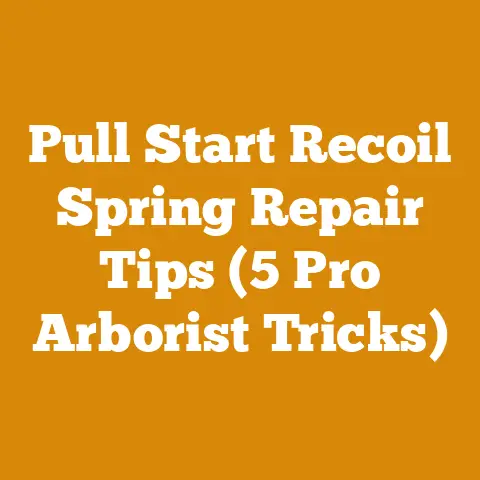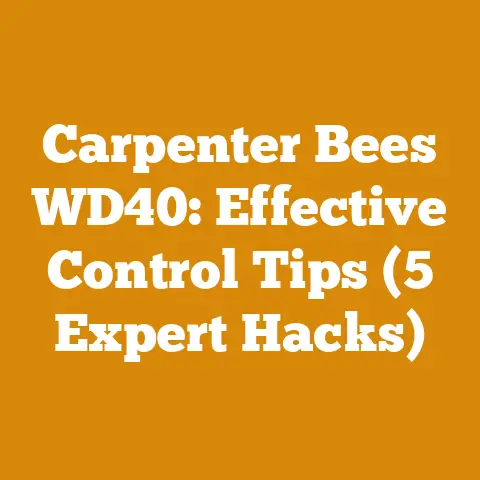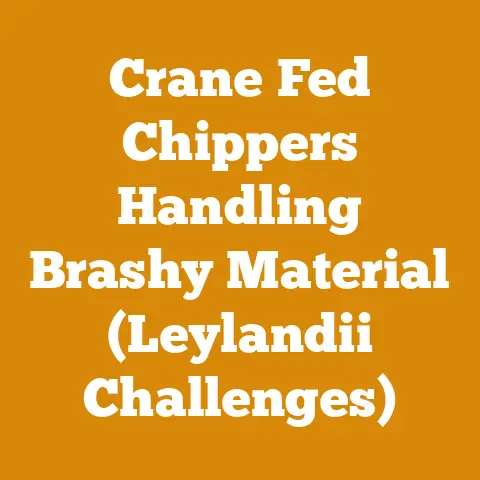Kill Poison Ivy on Trees (Expert Chainsaw & Arborist Tips)
Have you ever looked at a towering tree in your yard, admired its strength and beauty, only to notice a creeping vine of poison ivy snaking its way up the trunk? It’s a common problem, and one that can quickly escalate if left unchecked. Not only is poison ivy irritating to the touch, but it can also weaken trees over time. The intention of most people searching for “Kill Poison Ivy on Trees (Expert Chainsaw & Arborist Tips)” is clear: they want to safely and effectively eliminate poison ivy without harming their trees or themselves. As someone who’s spent years working with trees, chainsaws, and the challenges of land management, I’m here to guide you through the process.
Understanding the Enemy: Poison Ivy
Before we grab any tools, let’s understand what we’re dealing with. Poison ivy (Toxicodendron radicans) is a vine that contains urushiol, an oil that causes an allergic reaction in most people. It’s incredibly resilient and can grow as a ground cover, shrub, or, most commonly, as a climbing vine on trees.
- Identification: Look for the classic “leaves of three, let it be” adage. Each leaf cluster has three leaflets. The vine itself can be hairy and reddish.
- The Problem: Poison ivy competes with the tree for resources, can block sunlight, and its weight can sometimes contribute to branch breakage, especially after rain or snow. The primary concern, of course, is the risk of skin contact and the resulting rash.
Safety First: Protecting Yourself
Working around poison ivy requires strict adherence to safety protocols. Urushiol can remain active on surfaces for years, so prevention is key.
- Protective Gear:
- Gloves: I always recommend heavy-duty, disposable nitrile gloves underneath a pair of durable work gloves. This provides a double layer of protection.
- Clothing: Wear long sleeves, long pants, and a hat. Tuck your pants into your boots or use duct tape to seal any gaps. I’ve learned the hard way that even a tiny exposed patch of skin can lead to days of misery.
- Eye Protection: Safety glasses or goggles are essential, especially when using tools that could fling plant debris.
- Respirator (Optional): If you’re sensitive to poison ivy or are dealing with a large infestation, consider wearing a respirator to avoid inhaling any urushiol particles.
- Barrier Creams: Apply a barrier cream containing bentoquatam (e.g., Ivy Block) to exposed skin before starting. These creams create a protective layer that can help prevent urushiol from penetrating the skin.
- Washing Up: Immediately after finishing, carefully remove your gloves and clothing. Wash your hands thoroughly with soap and water. Wash your clothing separately in hot water with detergent. Consider showering as soon as possible, using a specialized poison ivy soap (e.g., Tecnu or Zanfel). These soaps are designed to remove urushiol from the skin.
- Tool Cleaning: Thoroughly clean any tools that may have come into contact with poison ivy using a strong degreaser or rubbing alcohol.
Methods for Killing Poison Ivy on Trees
There are several methods for tackling poison ivy on trees, each with its pros and cons. I’ll cover both manual removal and herbicide application.
1. Manual Removal: The “Cut and Dig” Approach
This method is labor-intensive but effective, especially for smaller infestations or when you want to avoid herbicides.
- Step 1: Cutting the Vine:
- Use loppers or a pruning saw to cut the poison ivy vine at the base of the tree. Make the cut as close to the ground as possible.
- Important: Dispose of the cut vine carefully. Do not burn it, as burning poison ivy releases urushiol into the air, which can cause severe respiratory irritation. I usually bag it in a heavy-duty garbage bag and dispose of it according to local regulations.
- Tool Specifications: Loppers with a blade length of at least 24 inches provide good leverage. A pruning saw with a 12-14 inch blade is ideal for thicker vines.
- Step 2: Digging Out the Roots:
- Use a shovel or trowel to carefully dig around the base of the cut vine and remove as much of the root system as possible. Poison ivy roots can be surprisingly extensive, so be thorough.
- Pro Tip: Wetting the soil slightly can make it easier to dig around the roots.
- Step 3: Removing the Vine from the Tree (Carefully!):
- This is where things get tricky. The vine attached to the tree will eventually die, but it can take a while, and the urushiol will remain active.
- Option 1: Leave it Alone. If the vine is high up and doesn’t pose an immediate threat, you can simply leave it to decompose naturally. This is often the safest option.
- Option 2: Manual Removal (with Extreme Caution). If you choose to remove the vine, wear full protective gear. Use a gloved hand or a tool like a putty knife or pry bar to gently pry the vine away from the tree bark. Avoid ripping the vine, as this can release urushiol.
- Case Study: I once had a client with a large oak tree completely covered in poison ivy. We opted to cut the vine at the base and let the upper portion die and decompose naturally. It took about a year, but eventually, the vine crumbled away without us having to risk direct contact.
- Step 4: Monitoring and Follow-Up:
- Poison ivy is persistent. Regularly monitor the area for new growth and repeat the process as needed.
2. Herbicide Application: A More Aggressive Approach
If manual removal isn’t feasible or you’re dealing with a large infestation, herbicides can be an effective solution. However, it’s crucial to use them responsibly and with caution to avoid harming the tree or the environment.
- Choosing the Right Herbicide:
- Glyphosate: A non-selective herbicide that kills most plants it comes into contact with. Use with extreme caution around desirable plants. I generally avoid using glyphosate near trees unless I can very carefully target the poison ivy.
- Triclopyr: A selective herbicide that is more effective on woody plants like poison ivy and less likely to harm grasses. This is often my preferred choice for poison ivy control near trees.
- Important: Always read and follow the manufacturer’s instructions on the herbicide label. Pay close attention to safety precautions, application rates, and environmental considerations.
- Application Methods:
- Cut-Stem Treatment: This is the most targeted and effective method for killing poison ivy on trees.
- Step 1: Cut the poison ivy vine at the base of the tree, as described in the manual removal section.
- Step 2: Immediately apply the herbicide to the freshly cut stump. Use a paintbrush, spray bottle, or a specialized herbicide applicator. The goal is to saturate the cut surface with the herbicide before it has a chance to seal over.
- Step 3: Monitor the area for new growth and reapply herbicide as needed.
- Foliar Spray: This involves spraying the herbicide directly onto the leaves of the poison ivy. It’s less targeted than the cut-stem treatment but can be useful for treating ground cover or smaller vines.
- Important: Avoid spraying the herbicide on the tree’s foliage. Use a shield or cardboard to protect the tree from overspray. Apply the herbicide on a calm day to prevent drift.
- Cut-Stem Treatment: This is the most targeted and effective method for killing poison ivy on trees.
- Timing is Key:
- The best time to apply herbicides is when the poison ivy is actively growing, typically in the spring or early summer. This allows the herbicide to be effectively absorbed and transported throughout the plant.
- Case Study: I once used triclopyr to control a large poison ivy infestation on a property bordering a sensitive wetland area. We used the cut-stem treatment method, carefully applying the herbicide only to the cut stumps of the poison ivy vines. This minimized the risk of herbicide runoff and protected the surrounding ecosystem.
3. Combining Methods: The Best of Both Worlds
In some cases, the most effective approach is to combine manual removal and herbicide application. For example, you could manually remove as much of the poison ivy as possible and then use a cut-stem treatment to kill any remaining roots or vines.
Chainsaws and Poison Ivy: A Word of Caution
While chainsaws are essential tools for many tree care tasks, they are rarely necessary or appropriate for killing poison ivy on trees. The primary reason is safety. Using a chainsaw near poison ivy significantly increases the risk of exposure to urushiol.
- When Chainsaws Might Be Used (Rarely):
- If the poison ivy has completely engulfed a small, dead tree or branch, a chainsaw might be used to carefully remove the entire thing. However, this should only be done by experienced chainsaw operators wearing full protective gear.
- Alternatives:
- Loppers, pruning saws, and hand tools are generally safer and more effective for removing poison ivy from trees.
Tree Health Considerations
When dealing with poison ivy, it’s important to consider the health of the tree itself.
- Inspect the Tree: Look for signs of stress or damage, such as dead branches, decay, or insect infestations.
- Avoid Damaging the Bark: Be careful not to damage the tree’s bark when removing poison ivy. The bark protects the tree from disease and insects.
- Provide Proper Care: Ensure the tree receives adequate water, nutrients, and sunlight. This will help it recover from any stress caused by the poison ivy.
- Consult an Arborist: If you’re concerned about the health of your tree, consult a certified arborist. They can provide expert advice and recommend appropriate treatments.
Firewood and Poison Ivy: A Dangerous Combination
Never burn poison ivy in a fireplace or wood stove. Burning poison ivy releases urushiol into the air, which can cause severe respiratory irritation and skin reactions.
- Safe Disposal: Dispose of poison ivy vines and roots in a sealed garbage bag according to local regulations.
Preventing Future Infestations
Once you’ve successfully killed the poison ivy, take steps to prevent it from returning.
- Maintain a Healthy Lawn: A dense, healthy lawn can help prevent poison ivy from establishing itself.
- Mulch Around Trees: Mulch can help suppress weed growth and prevent poison ivy from climbing trees.
- Regular Monitoring: Regularly inspect your property for new poison ivy growth and take action promptly.
- Education: Teach family members and neighbors how to identify poison ivy and avoid contact with it.
Detailed Look at Tools and Materials
Let’s dive deeper into the tools and materials I’ve mentioned, including specific models and specifications I’ve found reliable over the years.
Cutting Tools:
- Loppers:
- Model Recommendation: Fiskars PowerGear2 Lopper. These loppers offer excellent cutting power and leverage, making it easier to cut through thick poison ivy vines.
- Specifications: Blade length: 24-32 inches, Cutting capacity: Up to 2 inches.
- Strategic Advantage: The gear mechanism amplifies your cutting force, reducing strain and fatigue.
- Pruning Saw:
- Model Recommendation: Corona RazorTOOTH Folding Pruning Saw. This saw is lightweight, easy to carry, and has a sharp, durable blade.
- Specifications: Blade length: 10-14 inches, Blade type: Curved or straight.
- Strategic Advantage: The folding design makes it safe to store and transport. The razor-sharp teeth provide clean, efficient cuts.
- Hand Pruners:
- Model Recommendation: Felco F-8 Classic Pruner. These pruners are known for their durability and precision.
- Specifications: Cutting capacity: Up to 1 inch.
- Strategic Advantage: The ergonomic design reduces hand fatigue. The replaceable blade ensures long-term use.
Herbicide Applicators:
- Paintbrushes:
- Specifications: 1-2 inch wide, synthetic bristle.
- Strategic Advantage: Inexpensive and readily available. Good for applying herbicide to small areas.
- Spray Bottles:
- Specifications: Adjustable nozzle, chemical-resistant.
- Strategic Advantage: Allows for targeted application of herbicide.
- Herbicide Applicator Pens:
- Model Recommendation: Weed Ender Dauber Herbicide Applicator.
- Strategic Advantage: Precise application, minimizes herbicide waste.
Protective Gear:
- Gloves:
- Specifications: Heavy-duty nitrile gloves (at least 8 mil thickness) under durable work gloves.
- Strategic Advantage: Double layer protection against urushiol.
- Clothing:
- Specifications: Long sleeves, long pants made of durable, tightly woven fabric.
- Strategic Advantage: Provides a physical barrier against poison ivy.
- Eye Protection:
- Model Recommendation: Pyramex I-Force Safety Goggles.
- Strategic Advantage: Provides a secure seal around the eyes, preventing debris and herbicide from entering.
- Respirator:
- Model Recommendation: 3M 7500 Series Half Facepiece Reusable Respirator with P100 filters.
- Strategic Advantage: Protects against inhaling urushiol particles.
Herbicides:
- Glyphosate:
- Brand Recommendation: Roundup.
- Concentration: Follow the manufacturer’s instructions for the specific product.
- Strategic Advantage: Effective on a wide range of plants.
- Triclopyr:
- Brand Recommendation: Garlon 4 Ultra.
- Concentration: Follow the manufacturer’s instructions for the specific product.
- Strategic Advantage: More selective than glyphosate, less likely to harm grasses.
Cost Analysis
Let’s break down the costs associated with each method.
Manual Removal:
- Initial Investment:
- Loppers: \$30-\$50
- Pruning Saw: \$20-\$40
- Gloves: \$10-\$20
- Protective Clothing (if needed): \$50-\$100
- Total: \$110-\$210
- Ongoing Costs:
- Replacement gloves: \$10-\$20 per use
- Disposal bags: \$5-\$10 per use
- Labor:
- Highly variable, depends on the size of the infestation and your hourly rate.
Herbicide Application:
- Initial Investment:
- Herbicide: \$20-\$50 per bottle
- Applicator (paintbrush, spray bottle, etc.): \$5-\$20
- Gloves: \$10-\$20
- Protective Clothing (if needed): \$50-\$100
- Total: \$85-\$190
- Ongoing Costs:
- Herbicide refills: \$20-\$50 per use
- Replacement gloves: \$10-\$20 per use
- Labor:
- Less labor-intensive than manual removal.
Cost Comparison:
Manual removal has a higher initial investment in tools, but lower ongoing costs. Herbicide application has a lower initial investment but higher ongoing costs for herbicide refills. The best method depends on the size of the infestation, your budget, and your preference for using chemicals.
Addressing Challenges Faced by Global DIYers and Small-Scale Logging Businesses
I understand that DIYers and small-scale logging businesses around the world face unique challenges when dealing with poison ivy. Here are some considerations:
- Access to Tools and Materials: In some regions, access to specialized tools and herbicides may be limited. Consider sourcing tools and materials online or from local suppliers.
- Cost: Budget constraints may limit your ability to purchase expensive tools or herbicides. Prioritize essential safety gear and consider using manual removal methods when possible.
- Environmental Regulations: Be aware of local environmental regulations regarding herbicide use and disposal. Choose environmentally friendly alternatives when available.
- Language Barriers: If you’re working in a region where English is not the primary language, translate safety instructions and herbicide labels carefully.
- Climate: Climate can affect the growth and spread of poison ivy. Adjust your control methods accordingly.
Strategic Insights and Tactical Instructions
Here’s a summary of strategic insights and tactical instructions to help you effectively kill poison ivy on trees:
- Strategic Insight: Prevention is key. Regularly monitor your property for new poison ivy growth and take action promptly.
- Tactical Instruction: Wear full protective gear whenever working around poison ivy.
- Strategic Insight: Choose the right method for the job. Manual removal is best for small infestations, while herbicides are more effective for large infestations.
- Tactical Instruction: Use the cut-stem treatment method for targeted herbicide application.
- Strategic Insight: Consider the health of the tree. Avoid damaging the bark and provide proper care.
- Tactical Instruction: Consult an arborist if you’re concerned about the health of your tree.
- Strategic Insight: Never burn poison ivy.
- Tactical Instruction: Dispose of poison ivy vines and roots in a sealed garbage bag according to local regulations.
Next Steps and Implementation Guidance
Ready to tackle the poison ivy on your trees? Here’s a step-by-step guide to get you started:
- Assess the Situation: Identify the extent of the poison ivy infestation and the health of the affected trees.
- Choose Your Method: Decide whether to use manual removal, herbicide application, or a combination of both.
- Gather Your Tools and Materials: Purchase the necessary tools, herbicides, and protective gear.
- Plan Your Attack: Develop a detailed plan for removing or killing the poison ivy, taking into account safety precautions and environmental considerations.
- Implement Your Plan: Follow the steps outlined in this guide to carefully and effectively remove or kill the poison ivy.
- Monitor and Follow-Up: Regularly inspect the area for new growth and repeat the process as needed.
- Maintain a Healthy Landscape: Take steps to prevent future infestations by maintaining a healthy lawn, mulching around trees, and educating yourself and others about poison ivy.
By following these steps and using the information in this guide, you can successfully kill poison ivy on trees and protect yourself, your trees, and the environment. Remember to prioritize safety, be patient, and don’t be afraid to seek help from a certified arborist if needed. Good luck!






